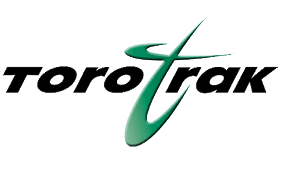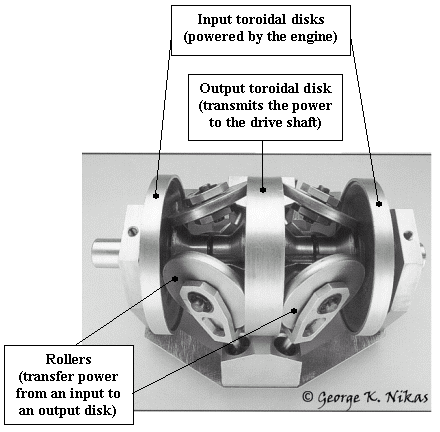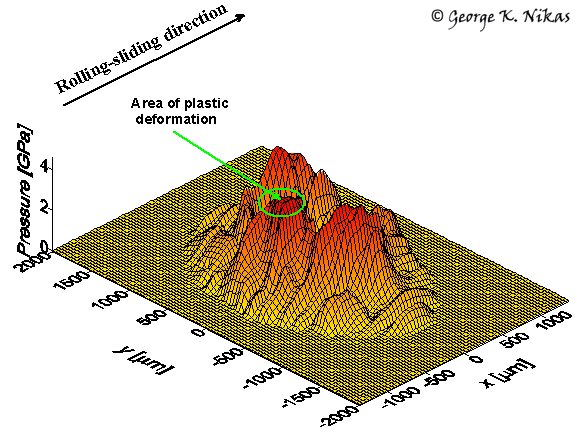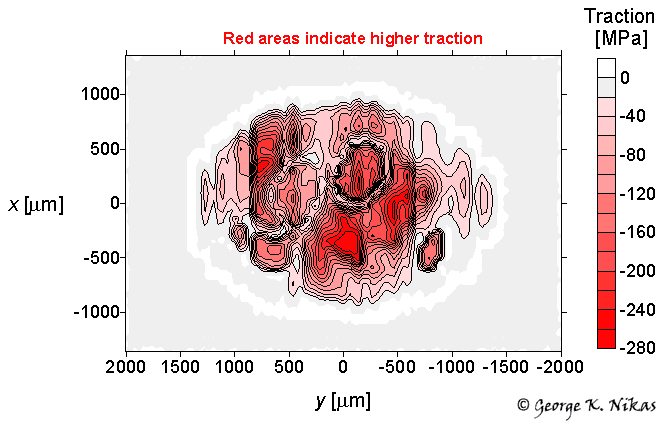
Project: Development of a contact fatigue model for Continuously Variable Transmissions.
Client:
Torotrak
(Development) Ltd (UK) 
Sponsor: Department of Trade and Industry (UK) ![]()
Researcher: Dr George K. Nikas (Imperial College London, Mechanical Engineering Department).
Supervisors:
Dr Richard Sayles (Imperial College London - Mechanical Engineering Department).
Mr Mervin Patterson (Torotrak (Development) Ltd).
Dr David Nicolson (Torotrak (Development) Ltd).
Project duration: 18 months (1998-1999).
Project cost: £83,500.
Technical report: A technical report was written by Dr Nikas and distributed to the supervisors of the project. The 88-page report contains 19 figures and 86 detailed equations.
Related computer software: program TORO. Elastohydrodynamic lubrication, three-dimensional stress analysis, and contact fatigue analysis of toroidal Infinitely Variable Transmissions. Written in Fortran. Code length: 2393 lines. Latest version: 2.5.2. Registered user: Torotrak (Development) Ltd (UK).
Summary
The target of this project was the development of a computer program to predict the life expectancy of a Continuously Variable Transmission (CVT). In the case of Torotrak, the patented transmission is called IVT (Infinitely Variable Transmission). The aim of this work was to model the lubrication, loading and wear of the rollers and the toroidal disks of the variator of the IVT (shown in the next figure).

The variator of Torotrak's Infinitely Variable Transmission.
Although the idea behind the IVT mechanism is simple, the tribological aspects of its internal workings are the most complicated that can be found in any machine element application. The model involves the following:
Solution of the elastohydrodynamic problem for elliptical contacts, including transient and non-Newtonian effects, as well as real rough surfaces (measured by a Taylor-Hobson device). The model is based on a generalized Reynolds equation that can incorporate any non-Newtonian rheology model available in the literature. Allowance is made for the cooperating surfaces to move in two perpendicular directions on the tangent plane of the contact. The tangential velocities of the cooperating surfaces and the load of the contact are all considered time-variables.
Allowance for roughness asperity elastoplastic interactions.
Three-dimensional sub-surface stress calculations based on the solution of the lubrication problem and any real contact (asperity) interactions as found in step (2) above. Plastic deformations of contacting asperities form a modified roughness profile of the surfaces. Thus, the surface wear can be predicted for any stage of the life of the IVT.
Application of the Ioannides-Harris contact-fatigue model to evaluate the life of the contact, based on the stress results from step (3).
Here follow a couple of figures from the author's simulation, based on Torotrak's IVT data. The figures are from a real rough contact and refer to the surface of one roller of the variator.

Fig. 1. Contact pressure for a rough contact (spin velocity excluded).

Fig. 2. Contour map of traction for the contact of Fig. 1.
A follow-up project of the author deals with the traction modelling of toroidal CVTs and offers improved accuracy in the contact fatigue analysis.
Publication of the author related to this work
Nikas, G. K. Fatigue life and traction modeling of continuously variable transmissions. ASME Journal of Tribology, 2002, 124(4), 689-698.